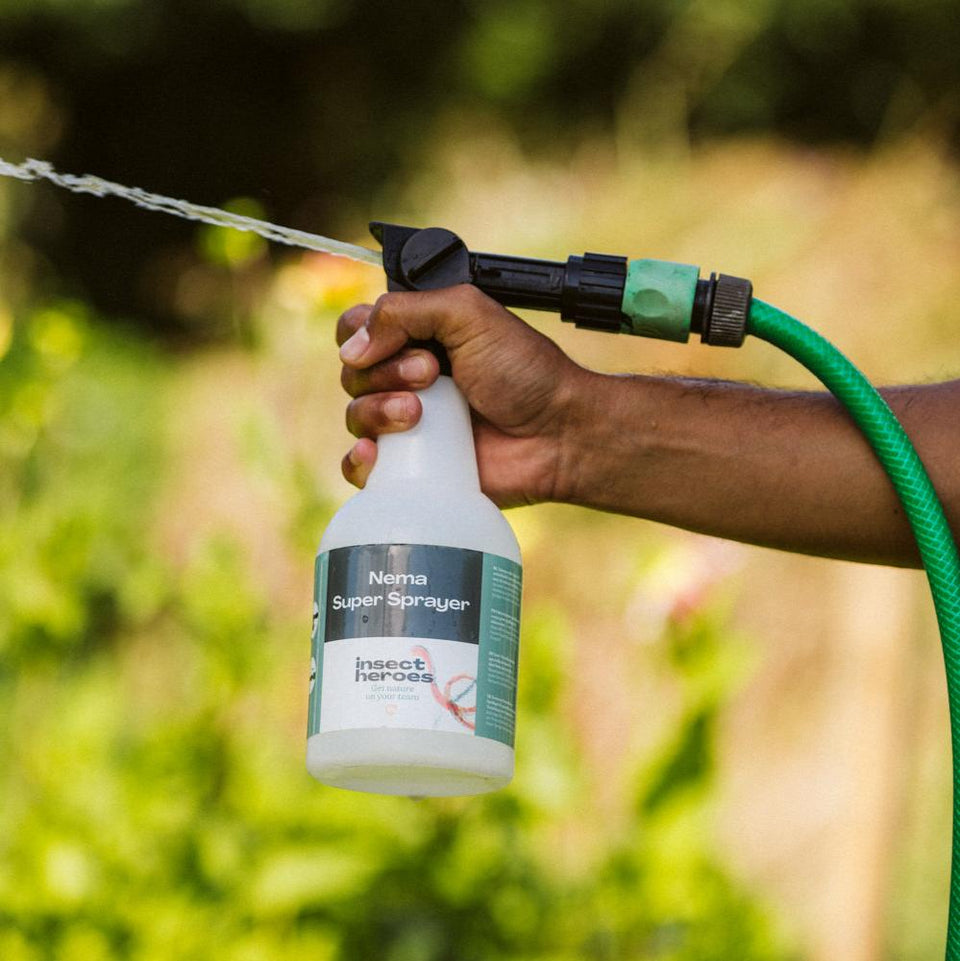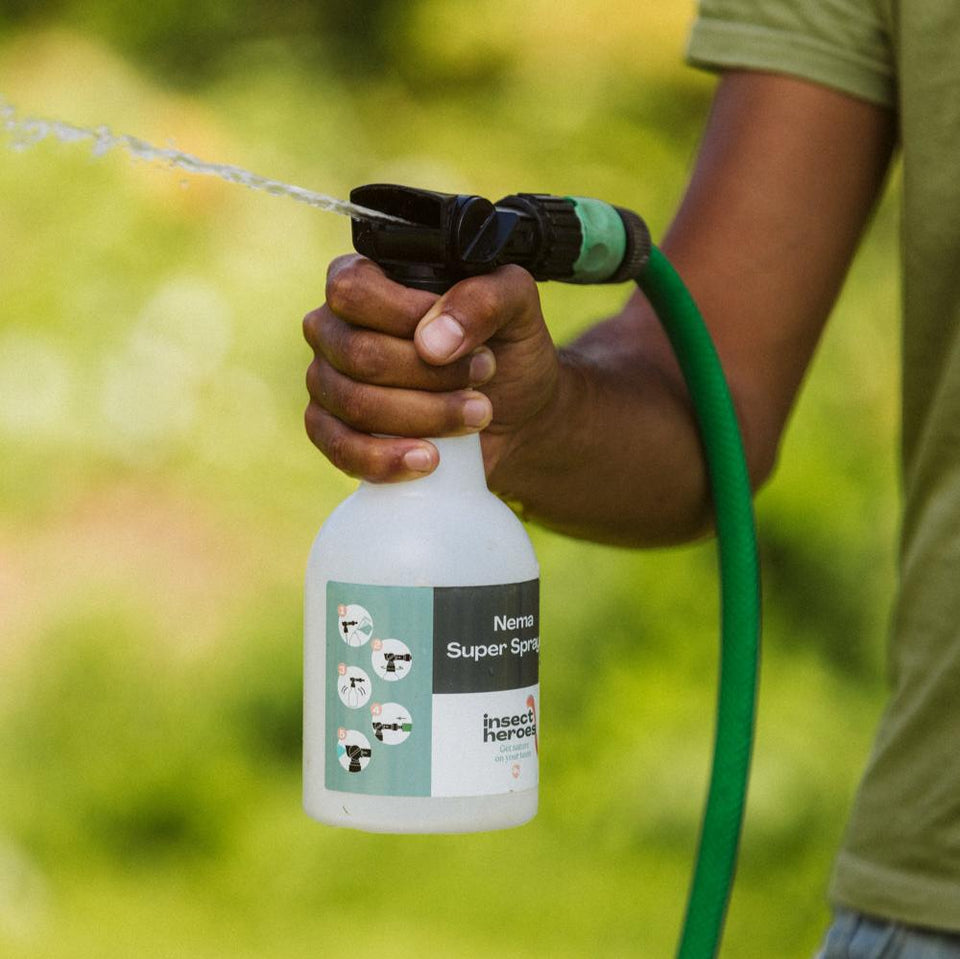Combating, recognizing and preventing leatherjackets
Wat zijn emelten?
Emelten zijn de larven van langpootmuggen. Vooral de koollangpootmug en de weidelangpootmug komen veel in Nederland voor en brengen de meeste schade aan.
Overdag blijven de larven verborgen in de grond, maar 's nachts komen ze tevoorschijn om aan de groene delen van planten te knagen, meestal zo dicht mogelijk bij de grond. De insectenlarven eten dus niet van de wortels van planten, zoals veel mensen denken. Deze vraatschade kan aanzienlijke schade aanrichten aan gazons, tuinen en landbouwgewassen.
Emelten herkennen
Emelten zijn de larven van langpootmuggen en kunnen tot 5 centimeter lang worden. Ze zijn te herkennen aan hun grijsbruine kleur en cilindrische, wormachtige vorm. In tegenstelling tot veel andere insectenlarven, zoals engerlingen of ritnaalden, hebben emelten geen duidelijke voor- of achterkant en missen ze pootjes. Dit maakt hen gemakkelijk te onderscheiden van engerlingen, die een gebogen lichaam en duidelijke pootjes hebben, en ritnaalden, die een stevige, harde textuur en een meer uitgesproken kopstructuur vertonen.
Emelten ontwikkeling
De levenscyclus van emelten begint wanneer volwassen langpootmuggen in de late zomer of vroege herfst eieren leggen in vochtige grond. Na ongeveer twee weken komen de eieren uit en verschijnen de larven, de emelten. Deze larven voeden zich voornamelijk met groene delen van planten gedurende de herfst tot de lente. Tegen het einde van de lente verpoppen de emelten zich in de grond. Na een paar weken komen de volwassen langpootmuggen tevoorschijn, klaar om de levenscyclus opnieuw te beginnen.
Emelten schade
Jonge emelten die net uit het ei kruipen richten nog geen zichtbare schade aan. Ze eten dood organisch materiaal in de bodem en komen niet bovengronds. De oudere emelten richten wel schade aan.
Kale plekken in het gazon
Eind november, wanneer de larven hun derde stadium bereiken, wordt de meeste schade aan gazons zichtbaar. Dit komt doordat het gras in deze periode niet snel groeit, terwijl de emelten het gras wel opeten. De emelten graven gangen in de grond en komen 's nachts naar boven om bovengronds aan planten te eten. Ze voeden zich met onkruid of grasstengels en trekken de plantjes mee in hun gangen. Een hardnekkige fabel is dat emelten de wortels van het gras eten, maar dat doen ze niet.
Kale plekken door vogels
Naast de vraatschade die emelten veroorzaken, kunnen ook vogels zoals kraaien schade aanrichten. Niets zal deze dieren ervan weerhouden om de smakelijke emelten uit de grond te halen, vooral niet als ze een mooi gazon tegenkomen. Hierdoor ontstaan vaak omgewoelde grasstukken waar deze vogels op zoek zijn gegaan naar emelten.
Emelten bestrijden met aaltjes
Het bestrijden van emelten met aaltjes is een effectieve en milieuvriendelijke manier om van deze schadelijke larven af te komen. Aaltjes, ook wel nematoden genoemd, zijn microscopisch kleine wormpjes die emelten en andere insectenlarven binnen kunnen dringen en een bacterie kunnen overbrengen. De bacterie doodt uiteindelijk de emelten. Hier lees je hoe je deze biologische bestrijdingsmethode eenvoudig kunt toepassen.
Stap 1: Kies de juiste aaltjes
Voor het bestrijden van emelten zijn Felti of Carpo aaltjes het meest geschikt, afhankelijk van de tijd van het jaar dat je ze gebruikt. Bewaar de aaltjes in de koelkast totdat je ze gaat gebruiken.
Stap 2: Bereid de aaltjes voor
Meng de aaltjes met water volgens de aanwijzingen op de verpakking. Het is belangrijk om dit mengsel goed te roeren zodat de aaltjes gelijkmatig worden verdeeld. Gebruik het mengsel direct na het bereiden om de effectiviteit te behouden. Pas bij voorkeur 's avonds of bij een bewolkte dag toe, de aaltjes kunnen niet goed tegen UV-licht. Zorg ervoor dat de aaltjes met genoeg water worden toegepast, zodat ze niet uitdrogen.
Stap 3: Toepassing van aaltjes
Breng het mengsel van aaltjes en water aan op de getroffen gebieden met behulp van een gieter of sproeier. Zorg ervoor dat de grond vochtig blijft na de toepassing, zodat de aaltjes zich kunnen verspreiden en hun werk kunnen doen. Sproei zo nodig na met de tuinslang zodat de aaltjes goed de bodem in kunnen trekken.
Stap 4: Herhaal de behandeling
Voor een succesvolle bestrijding is het vaak nodig om de behandeling meerdere keren te herhalen. Dit is vooral belangrijk bij zware infestaties. Meestal zijn twee tot drie behandelingen per seizoen voldoende om de emeltenpopulatie onder controle te krijgen. Lees verder op de pagina meer over wanneer je emelten het beste met aaltjes kunt bestrijden.
Wanneer emelten bestrijden?
De beste tijd om emelten te bestrijden met aaltjes is in de periode van september tot en met begin november. Op dat moment zijn de emelten namelijk nog klein en makkelijker voor de aaltjes om te parasiteren. In deze periode is nog niet veel schade zichtbaar. In het najaar kan je het beste het Felti aaltje gebruiken. De optimale bodemtemperatuur voor de inzet van deze aaltjes ligt boven de 10°C.
In het voorjaar en in de zomer is het mogelijk om een herhaalbehandeling aaltjes uit te zetten in de periode maart tot juni. Voor bodemtemperaturen boven de 14 graden kunnen de Carpo aaltjes het beste gebruikt worden.
Tips om emelten te voorkomen
Voorkomen is beter dan genezen! Om emelten te voorkomen, kun je de volgende maatregelen nemen:
Houd je bodem en gazon gezond
Een sterk en gezond gazon is minder vatbaar voor emelten. Regelmatig bemesten, beluchten en correct maaien helpt hierbij. Zorg voor een goed gedraineerde bodem, want emelten gedijen in vochtige omstandigheden. Geef je gazon bij voorkeur in de vroege ochtend water in plaats van 's avonds. Dit vermindert de kans op een vochtige bodem, wat aantrekkelijk is voor emelten.
Natuurlijke vijanden aantrekken
Stimuleer de aanwezigheid van natuurlijke vijanden zoals vogels en egels in je tuin. Dit kan door nestkasten op te hangen en een gevarieerde tuin aan te leggen.
Preventief aaltjes inzetten
Vermoed je aanwezigheid van emelten? Zet dan Carpo of Felti aaltjes uit.
Regelmatig controleren
Voer regelmatig inspecties uit op je gazon om vroege tekenen van emelten te detecteren. Op deze manier kun je snel ingrijpen voordat de schade te groot wordt.
Andere manieren om emelten te bestrijden
Emelten vangen
Emelten kunnen worden gevangen door 's nachts een zwart plastic zeil of een vuilniszak neer te leggen. De emelten zullen hierdoor denken dat het nacht is en naar boven komen. In de ochtend kun je ze dan eenvoudig vangen en verwijderen van onder het zwarte plastic.
Emelten bestrijden met knoflook
Een methode om emelten aan te pakken is het gebruik van knoflookextracten. De sterke geur van knoflook zou emelten kunnen weren, maar deze geur is ook onaangenaam voor mensen. Hoewel sommigen beweren dat knoflook de groei van emelten belemmert, is hier geen wetenschappelijk bewijs voor gevonden. Bovendien zorgt knoflook er niet voor dat de emelten daadwerkelijk worden bestreden of verdwijnen.
Emelten chemisch bestrijden
Een andere optie is het chemisch bestrijden van emelten. We raden dit echter sterk af omdat chemische middelen niet alleen emelten aanpakken, maar ook het gehele bodemleven aantasten. Deze stoffen werken meestal op het zenuwstelsel van insecten en maken geen onderscheid tussen verschillende soorten. Dit kan ernstige schade toebrengen aan het bodemecosysteem, wat vervolgens invloed heeft op de gezondheid van planten en gazons. Daarom adviseren we altijd om ecologische methoden van plaagbestrijding te gebruiken, in lijn met onze missie en visie voor een duurzame en gezonde omgeving.
Weet je niet zeker van welke plaag je last hebt?
Bekijk de overzichtspagina met alle plagen.



















































